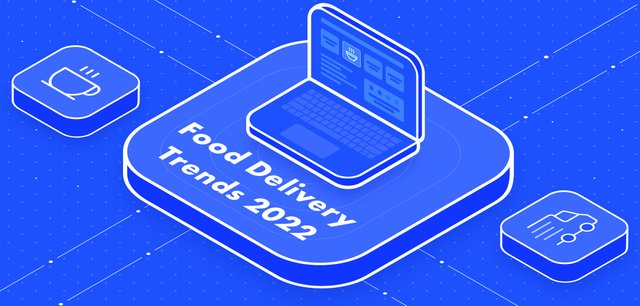Top 7 online food delivery trends in 2022 to get ideas for business development

With the increased penetration of the Internet and smartphones, the food delivery industry is witnessing rapid growth. Expert Market Research reports that the worldwide online food delivery market size is anticipated to spike from nearly $213 billion in 2020 to about $465 billion by 2026, progressing at a CAGR of 14.5% during the forecasted period.
The COVID-19 pandemic significantly affected the foodservice sector. Aiming to attract customers and ensure business continuity, many cafes and restaurants were forced to create user-friendly apps and websites that made food ordering a convenient process with no queues.
According to Bloomberg Second Measure, 50% of US consumers purchased meal delivery in September 2021, up from 44% compared to the previous year. It is worth noting that online food delivery marketplaces experienced a considerable startup valuation surge in the time of COVID-19, seeing a surge of 132%.
As the environment is as competitive as it has never been before, providers need to adopt new delivery models and innovative technologies. In this article, our software experts have described the main online food delivery trends for 2022, so that you can get ideas for business development. Have a look.
Top 7 online food delivery trends for 2022
1. Online food delivery marketplaces
The popularity of online food delivery marketplaces has significantly climbed during coronavirus. With the view to stay operational and cut expenditures, cafes, restaurants, and grocery stores are registering on foodservice marketplaces.
This way, the demand for marketplace platforms similar to Uber Eats and DoorDash is increasing. These two companies have seen the most substantial growth in average spending per consumer over the past two years. For DoorDash, the average paycheck per customer in the third quarter of 2021 was 114% higher compared with that same time period of 2019.
At Uber Eats, the average sales check per client jumped by 92% in Q3 2021. Find out how to launch a food delivery app like Uber Eats, from features that you should implement to the required time and budget.
Other well-known online food delivery marketplaces, such as Grubhub and Postmates, also experienced sales uplift between 2019–2021. Since marketplaces provide a fast start and simplified access to the audience, this trend is poised to prevail in the dining environment.
As the market is expected to surge, investment in local food service marketplaces offers great investment opportunities. For instance, Wolt, a Finnish-based startup, was able to attract $530 million at the beginning of 2021. Established in 2014, Wolt managed to triple its revenue to $330 million against a net loss of $38 million.
Another successful local startup is Membo. Founded in 2020, Membo launched a marketplace app to bring together Estonian food producers and consumers. As of summer 2021, the platform served more than 800 items from 65 vendors in Tallinn and Tartu. To date, Membo has raised $125,000 over one round.
Other examples of local online food delivery marketplaces are iFood and Swiggy that operate in Brazil and India, respectively. By now, iFood has fundraised $591.9 million while Swiggy has attracted a total of $3.7 billion.
2. Food ordering via smartphones
Mobile ordering is among the key online food delivery trends for 2022. When dining places were closed because of the COVID-19 pandemic, customers relied heavily on mobile-first food delivery services.
Mobile food app downloads hit virtually 170 million in Europe during the first three quarters of 2021, rising by 44% from the same period in 2019, according to Sensor Tower. Analysts predict that food application installs will reach over 60 million in Q4 2021.
As the demand for mobile ordering climbed, some well-known and large restaurant chains decided to design buildings to handle a growing number of orders. Restaurant Business informs that Burger King developed a prototype featuring a lane for mobile and delivery orders.
Chipotle Mexican Grill created its 100th “Chipotlane” to faster serve consumers ordering food via smartphones. This strategy was so effective that company owners are going to launch more lanes of this kind in the future. With a mobile application, Domino’s also witnessed a substantial upsurge in their digital sales that amounted to 75% during coronavirus.
A recent study found that 49% of survey participants would prefer to minimize human interactions by ordering and making payments, as well as booking tables via mobile devices. In this regard, the demand for marketplace development has risen. At Arateg, for example, our team has recently built a mobile food pre-ordering application for iOS and Android.
Additionally, experts revealed that 37% of consumers would like to track order status using a mobile app. Therefore, since mobile food ordering continues to prevail, cafes and restaurants need to create smartphone solutions and optimize websites for mobile devices.
3. Robotic food delivery
With the spread of the COVID-19 disease, robotic delivery witnessed an upsurge. MarketsandMarkets informs that the delivery robot market size is forecasted to spike from $212 million in 2021 to $957 million by 2026, registering a CAGR of 35.1% during the indicated period. The increasing adoption of innovative technologies, such as artificial intelligence, is poised to become a key market driver and provide great opportunities for businesses.
Robots are being actively adopted in the foodservice sector to automate the delivery process and meet the growing consumer demand. U.S. News reports that the number of delivery orders in the US rose by 66% in 2021 ending in June. Analysts also say that the popularity of robot-based meal delivery could remain high even after the ease of the pandemic.